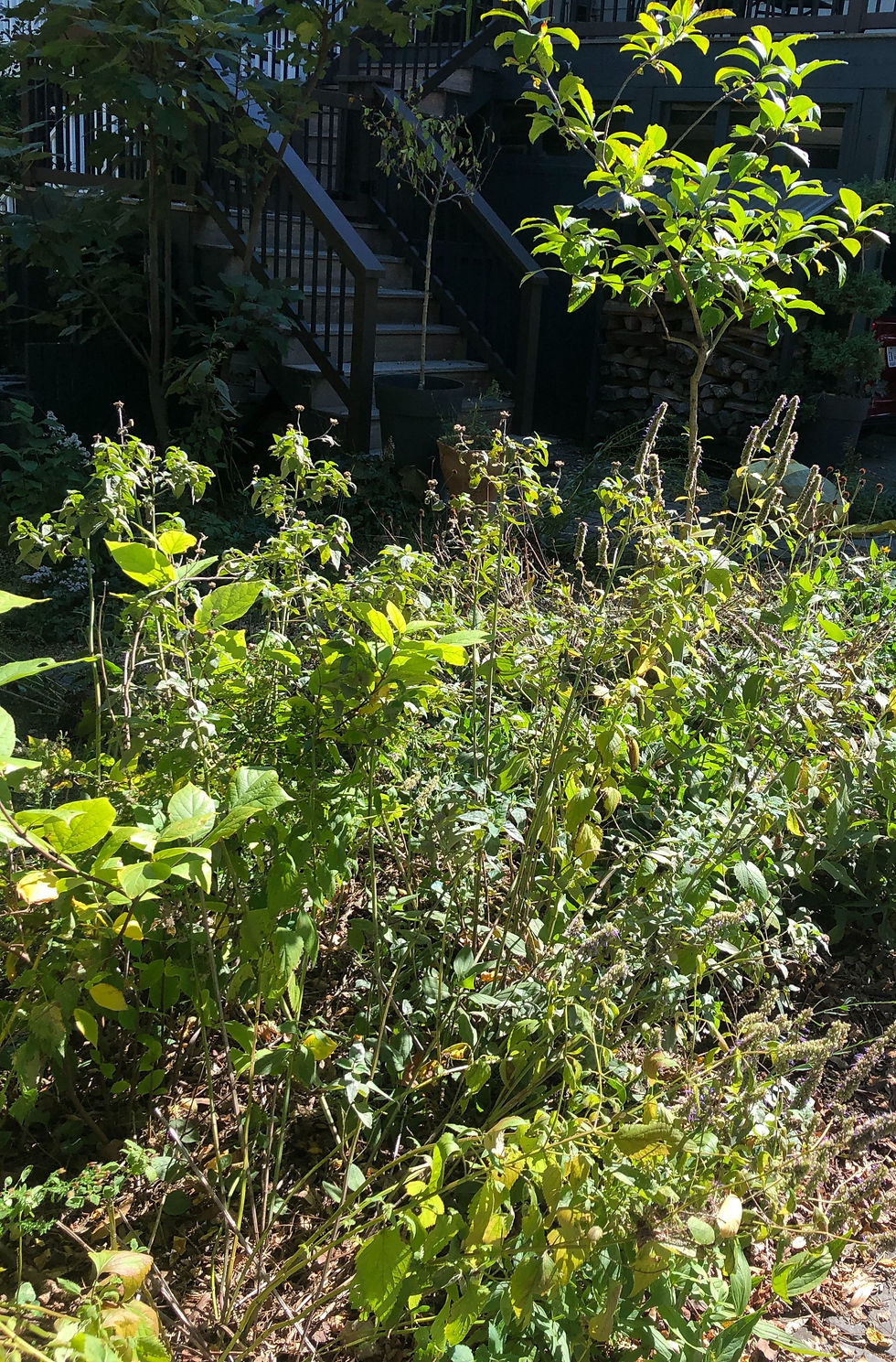Neatening A Native Garden Bed: Oh My!
- Nuts for Natives
- Oct 19, 2022
- 4 min read
Best intentions gone awry.
Our garden is like a lot of yours. There are definitely times when it all seems to come together -- the weather, the time of year and you think, ok, this is pretty good! Then there are times when it hasn't rained, not much is in bloom and things are less than their very best. That's when I tend to start looking around to see what can be better and that was what led to this.
In an effort to try growing lots of different native plants in our 1/8 acre of a garden, one of our few precious full sun locations had grown into quite a thicket of perennials, particularly after nine plugs of Eastern blue star I planted three years ago turned into three by four foot plants.
My original intention had been to create a small bank of the Eastern blue star native to the Chesapeake (Amsonia tabernaemontana), also sometimes called blue dogbane, along the driveway which would have striking yellow foliage in fall, much like another clump of threadleaf blue star (Amsonia hubrichtii) native to Arkansas and Oklahoma, in another spot in our garden. Eastern blue star has a wider leaf than the feathery foliage of the popular threadleaf blue star. It has the same blue flowers in spring and there is now a shorter cultivar too, Eastern blue star 'Short Stack' (Amsonia tabernaemontana 'Short Stack').
The problem was I kept adding native sun loving perennials while waiting for the blue star plugs to grow -- blue hyssop (they bloom for so long), black eyed susans (so easy to grow, cut and make arrangements with and the great seed heads later), mountain mint (it's such a pollinator magnet), goldenrod (fall color until the amsonia grow in) and then asters (because late season fall color is the best!). Each addition justified with enthusiasm. The small bed was bursting with plants. I even wrote a post on it describing how "to tame the fall," chelsea chop in May to reduce growth and tidy up the edges.

This year though it had really turned into a sprawling spot. With limited sun, I already had a free wheeling planting with many of the same plants out front that looked much better, so I decided I would transplant the Eastern blue star because, unlike the threadleaf blue star, these weren't really getting strong yellow color in fall. It seems to stay green and then die back. I have noticed that many trusted sources of plant information say the foliage of Eastern blue star may turn yellow.
Then with a bit more space, I would dig up the perennials and rearrange them into groups of like plants -- advice often given to use native plants in a more formal style .

I considered doing this in spring before everything starts growing but doubted my ability to distinguish between the different types of asters and goldenrods when the plants were just emerging. To make sure I could group like plants with like plants, I waited for fall when everything was blooming or had bloomed and I would know which plant was which. I did not want to wait too late because over wintering insects might already be tucked into plant stems or leaf litter for the winter so I decided a cool day in October would be the best time.
This past weekend, the ground was moist from several soaking rains, so it didn't take long to carefully dig up the perennials and put them in their groups. I left a small fringe tree (Chionanthus virginicus), a Carolina allspice (Calycanthus floridus) and a group of black-eyed susans in place.

Within two hours I had removed and replanted everything and divided and potted up twelve black-eyed susans and asters to give away. I gathered the broken stems and placed them on the ground in the middle of the bed as they could still provide over wintering locations for insects and seed heads for birds. I was feeling pretty productive.
As I was watering in the newly located plants, my heart sank. This caterpillar was quickly scurrying from the water. It was moving! I googled it and believe it is a giant leopard moth caterpillar which lives in leaf litter. While this one found a new home, who knows how many I might have inadvertently disrupted in my efforts to neaten a garden bed.
It's such a weird thing that we have this innate desire to neaten a garden, which is essentially nature. All of the scientists are telling us, leave the leaves and resist the urge to tidy. Seeing this furry little guy or gal really sealed it for me. I am going to stay out of the beds and leave the leaves as they are! Well, except for those on the grass. I'll rake them into the beds, perhaps slightly more gently though.
Leaving those leaves is the last step of our growing season -- growing more insects to grow more birds and wildlife! Taming the fall ... not so much.
Happy leaf season!













































Comments